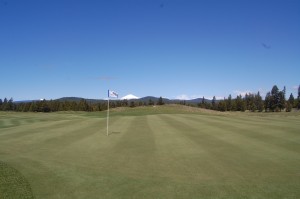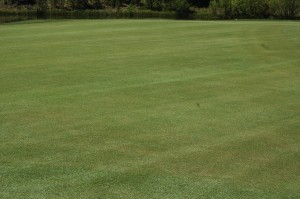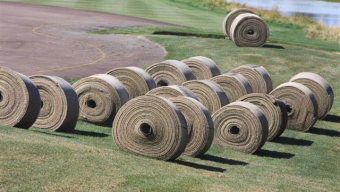SUNRIVER, Ore. – When highly-acclaimed Crosswater opened 17 years ago, it debuted as the first golf course in Central Oregon to use bent grass exclusively from tee to green.
The tees and fairways have the same bent grass now as back then, but a recent $500,000 project that took more than a year to prepare and six weeks to pull off has resulted in all 18 greens being restored to their original plush condition.
“The golf course is beautiful and these greens are absolutely pure,” exclaimed Jim Ramey, the Director of Agronomy for the Sunriver Resort. “The response has been overwhelmingly positive. They (golfers) love it.”
Part of my two-day, 72-hole golfing adventure with Bill Newlun, a longtime buddy and former junior college baseball teammate, was a round at Crosswater, a private club open to members, Crosswater home owners and Resort guests.
The course was closed last August 15 (temporary greens were set up for home owners and club members). Over an ensuing six-week period, 200,000 square feet of one-year-old bent grass T1 sod — grown near Boise, Idaho — was delivered via refrigerated trucks.
The project had to be finished by the end of September, before the days grew shorter and the nights became longer and colder. It was hell-on-wheels for those six weeks as the old greens were removed and prepared for the new grass. Truckload after truckload of the turf arrived for installation. Each load of sod was laid within 24 hours of arrival to prevent any kind of disease or damage being done to the turf.
The signature course at Sunriver Resort reopened this past Memorial Day weekend.
“We were supposed to have an Opening Day tournament for the members on the Friday before Memorial Day,” Ramey said, “but there was a dusting of snow on the course, so we had to push it back a day.”
The new greens have endured a busy schedule since the opening and Ramey sounded like a proud father while discussing the pristine surfaces and how well they have managed the heavy foot traffic.
“The first weekend was packed from morning until dark,” he said, “so there was a lot of play. I was real anxious to see how the greens would handle that much play so soon after being laid.”
Turns out all 18 greens came through with flying colors.
“I didn’t know what bent greens were,” Newlun said. “But I can tell you that these are the best greens I’ve ever seen. It’s like putting on a carpet.”
To my knowledge, it was the first time I had ever played on bent grass, greens or otherwise. The surface is absolutely plush and the putts are as true as they can be. Even the ball marks are barely visible on the surface.
“We couldn’t be happier with the way it turned out,” Ramey said.
The 38-year veteran grounds guru at the Resort explained that the best way to replace a green is to reseed it, the same method used in 1993-94. But to make sure the course would be closed as briefly as possible, it was decided to use sod to replace the 17-year-old greens that had been infiltrated by poa grass that is practically everywhere in this neck of the woods.
With so many golfers playing Crosswater after playing other non-bent grass courses in the area, it was inevitable that the poa would move in and try to take over.
“We were pure for 10-plus years, which is extraordinary, actually,” Ramey said. “But eventually, poa begins moving into your greens. As of now, there is not a selective herbicide for killing poa and not damaging bent grass. Every northern climate golf course is going to be invaded by poa at some point in time.”
 So why was bent grass used in the first place?
So why was bent grass used in the first place?
“The goal was for this to be a world-class golf course, a championship golf course,” he said. “There was a lot of back and forth on this, especially the fairways. Right from the beginning we knew it would be a challenge, and it was decided that this was going to be a world-class golf course built for the very best players. That’s the surface we wanted and needed for it to be world-class.”
Crosswater has been ranked among the top 100 courses in the U.S. for most of its life and the greens re-do surely will enhance its reputation.
The most difficult part of the project was getting the sod placed on the bare ground so evenly that the surface would be flat and smooth from one part of the green to another. Try that sometime at your home. Imagine trying to sod a 17,000 square-foot area – the size of the green on No. 9 – without leaving a wrinkle or a dent where water can settle.
The chipping and approach areas on all the holes also received the new-turf treatment.
“We didn’t change undulations or the chipping areas,” Ramey said, “but we may have tweaked some things so we didn’t trap water on the greens.”
When we played, the ball was rolling true but was a bit slow. But that’s the plan.
“It has taken us a month to get to the height of cut where we have a putting surface,” Ramsey said. “It’s fast enough to be a good putting surface but we’re not going to take it down to where it is so short that we’re going to compromise the health of the turf.
“We were snow covered two weeks ago, so we can’t force speed on them. We’re at a higher cut now than we will be in another month.”
And if all goes well, these greens might last 20-some years.





















